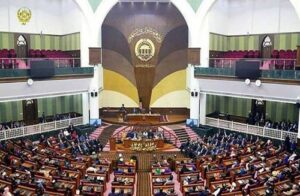
It has become almost a commonplace of public opinion in Afghanistan that the war will never end. In the absence of concrete and unified efforts by the Afghan government and its international allies, the nature of war has degenerated from periphery versus center to one in which the legitimacy of the government, as well as its democratic institutions, are highly challenged.
On the one hand, the Taliban lacks the necessary means to drive the international forces out of the country and as a result overturn the internationally-backed Kabul government by sheer military force. On the other hand, the ineffectiveness of government’s attempts to use a combination of methods, military and political, to persuade the Taliban to end their insurgency has only sobered the international actors and the ruling clique.
Just as international actors’ idealistic view of Afghan society and their unadjusted approach to bringing the conflict to an end precipitated the resurgence of armed opposition, so it can be argued, that the Afghan government’s scourging rhetoric towards Pakistan and an unbalanced foreign policy narrative geared towards isolating it has only strengthened the hands of the opposition groups.
Moreover, Afghanistan’s grandstanding under the shadow of India to counter Pakistan has not only done little to appreciably alter the mind of the Taliban but has also motivated other Pakistan-based militant groups to identify Afghanistan with Kashmir where they can pay India pack in its own currency.
President Ghani’s administration has boosted the peace agreement with Hezb-i-Islami of Gulbuddin Hekmatyar as a key measure of success for his administration’s handling of the country’s peace negotiations with the insurgents who are said to maintain close ties with Pakistani military establishment as well as like-minded Islamists across the border. Although during his election campaigns in 2014, the year which led to his disputed ascend to power, President Ghani promised significant changes in Afghanistan’s relations with Pakistan in ways that could be easily discerned from that of the previous administration under former President, Hamid Karzai. Conversely, with over a year left before facing the electorate for the next presidential elections, peace negotiations have stagnated and the relations with Pakistan is in free fall.

Adding to the complications, the United States in its new strategy for Afghanistan and South Asia invited India to play a greater and more visible role in Afghanistan’s peace and stability. Whereas economic war between India and China and the close military cooperation between India and Russia require, major global powers including the United States, to sustain if not strengthen support for Pakistan in the face of their vested interests. India’s tough and uncompromising attitude toward Muslims, not only in India but also in the region, will further solidify the position of Islamist fundamentalists and provide them with the opportunity to continue mobilizing violent actions within and without Pakistan which in return compels the international community to turn the heat up on Pakistan.
Relations between countries is a magnificent game of indefeasible interests and in that light India’s development aid to Afghanistan is also rarely an entirely altruistic business. India has a vested interest in Afghanistan in the sense it not only permits her to counter-balance closing ties between China and Pakistan in the regional geopolitical competition but also utilizes Pakistan’s interethnic conflict by supporting Baluch and Pashtun separatists and apply covert offensive to reprise Pakistan’s actions in Kashmir.

Afghanistan also does a balancing act between India and other major regional players such as Russia and the Islamic Republic of Iran. India has since independence maintained close military and economic ties with Russia as well as strived, particularly since the cold war, to improve relations with the United States to preserve its “non-aligned” credibility. After the U.S. revealed its plans in 2010 to buy Russian attack helicopters for Afghan Air Force before the idea was dropped over Crimea crisis, India came to the rescue and provided Afghanistan with four Mi-25 Russian made multirole helicopters. Although not a game-changing development in the Afghan conflict, such Indian involvement certainly saved America’s face but also increased Pakistan’s threat perception level.
Similarly, in a clash of competing narratives between the United States and Iran over its nuclear program, India is now on board with President Donald Trump’s administration to repeal that deal. By allowing India a greater space for politico-military maneuvers in Afghanistan the United States is killing many, not just two, birds with one stone. First, it balances China’s growing economic and military hegemony in South and East Asia. Second, it reprimands Pakistan for non-compliance. Third, the U.S. wants India to follow suit when it imposes new sanctions on Iran. Interestingly, such a deal is as beneficial for India as it is for the United States with additional rewards in the case of Iran. While India may side with the U.S. on Iran’s nuclear program, the trilateral mega economic projects between India, Iran, and Afghanistan will give clearance to India to still strike profitable deals with Iran.
Afghanistan, in general, and its foreign policy approach towards Pakistan in particular, promote and serve Indian interests to a great extent. However, Afghanistan is only paid peanuts by India. While the recent turn in policy events concerning Pakistan may greatly affect the rules of the game, Afghanistan needs to deepen its understanding of Pakistan’s insecurities and build bridges, not walls, between the two countries to resolve its security challenges.
Written by: Mohammad Naser Sidiqee – Development Expert
ENDS





